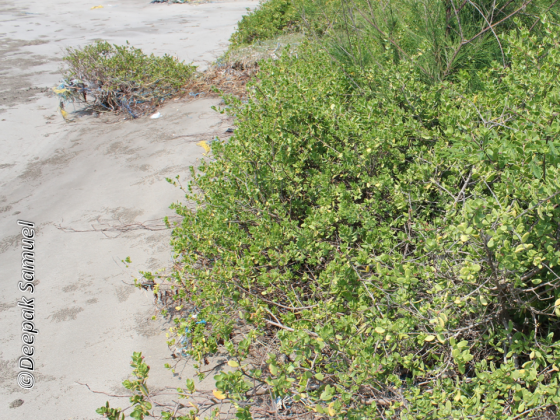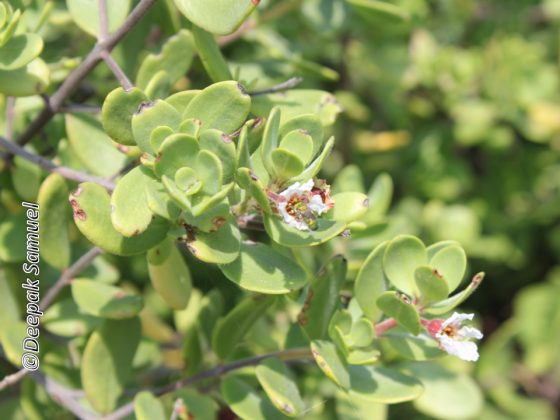
The Digging stick tree Pemphis acidula growing in the intertidal region. They are popular coastal species used for Bonsai culture
Bonsai is a term given to an ornamental tree or shrub grown in a pot and artificially prevented from reaching its normal size or the art of growing trees or shrubs in such a way. Terrestrial plants are popular for Bonsai cultivation but did you know that a coastal plant species is used for Bonsai cultivation?
Pemphis acidula, is a mangrove plant (A tree or shrub that grows in muddy, chiefly tropical coastal swamps is called a mangrove,) that is in demand for Bonsai culture. In India, Pemphis is reported to be endemic (Prevalent in or peculiar to a particular locality/ native to or confined to a certain region) to the Gulf of Mannar region though contradicting reports of its presence along the eastern coasts is also available.
Pemphis acidula is tropical and sub-tropical in distribution. It is also called as a DIGGING STICK TREE. In South Asia, this species is found in Indonesia, Japan, Philippines, Malaysia, Singapore, Sri Lanka, Viet Nam, and Thailand. Not many details are available for India except for the documentation of the species in the Gulf of Mannar region.
The digging stick tree is a typical sprawling mangrove species and can grow as a densely branched evergreen shrub or small tree. The leaves are succulent-type (Succulent plants, also known as succulents or fat plants, are water-retaining plants adapted to arid climate or soil conditions), pointed greyish- green and are arranged opposite to each other on thick woody branches. Flattened hairs are found all over the leaves.
Flowers of Pemphis are small and cup-shaped having colours of white or pale pink. The flowers are usually found to bloom throughout the year. Fruits/ berries are small, reddish in colour containing around 20 seeds. The seeds burst open after ripening and are transported by wind and water and settle down. If favourable conditions are available, the seed germinates and sprout into a small plant. There is very little information available about the biology of Pemphis acidula.
Pemphis can be located in calcareous rocky and sandy beaches high in the intertidal zone, and often above the high tide line. They play an important role in shoreline protection against high wind. It may also be found in areas of elevated coral reef.
Bonsai lovers started working with Pemphis in 1980’s in Indonesia but, the history of Bonsai preparation using this plant refers to Japan, Taiwan and the Philippines. The most popular designs made from Pemphis Bonsai are JIN and SHARI elements.
This plant has an elevated demand in the horticulture industry and statistics from scientific studies reveal an estimated 21% decline in mangrove area within this species range since 1980 (FAO 2007). In India, this coastal plant is hardly known except to botanists. Other threats include pollution from sewage effluents, solid wastes, siltation, oil, and agricultural and urban runoff. Climate change is also thought to be a threat, particularly at the edges of a species range. Natural threats include cyclones, hurricane and tsunamis (IUCN, 2013).
Taxonomic status
Kingdom: Plantae
Phylum: Tracheophyta
Subclass: Magnoliidae
Order: Myrtales
Family: Lythraceae
Genus: Pemphis
Species: P. acidula
Authors: Forst & Forst, 1775
© Deepak Samuel – July, 2013


informative and innovative sir
thanks Peninal.. keep reading..
Dear Deepuma:
1) I saw your catalogue on Mangroves after your Gujarath visit.
2) They are Water Banyan Trees, and shelters fishes,insects, and even Tigers in W Bengal.
3) Indeed they are decorative shrubs , to look at and deeper as you think they are meaningful requirements God has created for eco-balancing Sea creatures and the weather as well.
Lovely indeed !
M Premil Kumar
thanks a lot dada.. do keep reading!